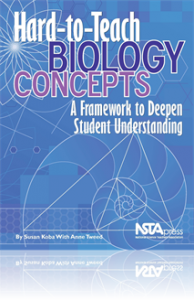
I purchased this book a number of years back but was pretty overwhelmed by it there is a lot of stuff in there and I just didn’t take the time necessary to really flesh out the information in there. This past NSTA National conference at Boston, I saw that the book and its authors Susan Koba and Anne Tweed were presenting about it. I was compelled to attend the session and boy am I glad I did. First off I found out they are planning on a new edition to match NGSS in the near future (seems like so many books are doing just that)
The concept is simple and I don’t know why I didn’t get it – actually I think its because I skipped the first few chapters where all the explanation was found and jumped right into the frameworks. But now that I was able to listen to both Susan and Anne I understood the concepts much better. I even suggested after the session that they consider adding a DVD to the next edition so that they could go through the process like they had with us. They both seemed to like that idea.
So here it goes … The first phase is called the predictive phase (which I think they are simply changing to Identifying essential context)
1. Determine what the learning goals are
2. Break it down into smaller learning targets
3. Connect the learning goals into a logical sequence
4. Provide success criteria (aka performance expectations)
The process that follows is called the responsive phase which uses the students preconceptions and misconceptions to adjust teaching.
1. Elicit preconceptions (Keeley’s formative probes?) and get the students to verbalize these
2. Gather the information about the students preconceptions and misconceptions
3. Create learning experiences to confront those pre and misconceptions (called sense making) which if done correctly will force the students to change their concepts into “durable” understandings (I love that statement)
4. Formally assess the students – if progress has been made go on to the next learning target – if the students have not met the success criteria (performance expectations) then they return to the same cycle
To relate to the new NGSS, they would start with the DCIs and then on to the Cross Cutting Concepts and the Science practices. Ideally each learning target contains all three. They suggest teasing out the three domains into what they call “developing a story line”. Organize the order of the Learning topic by DCIs then address the cross cutting concepts (like Models for instance) then Practices (“develop and use a model based on evidence to illustrate the relationships between systems or between components of a system”) and then using all of that find a representation or activity to include.
It truly is simple but pretty complex at the same time – but whats most important is that it makes sense. It is a systematic way to both address the concepts in science and the students thinking. I am also reading Page Keeley’s Curriculum Topic Study which seems to really fit into this approach, but more on that later.